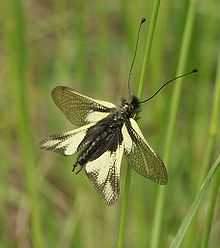Owlfly
| Owlflies Temporal range: Late Jurassic–Recent | |
|---|---|
 | |
| Male Libelloides coccajus | |
| Scientific classification | |
| Kingdom: | Animalia |
| Phylum: | Arthropoda |
| Class: | Insecta |
| Order: | Neuroptera |
| Suborder: | Myrmeleontiformia |
| Superfamily: | Myrmeleontoidea |
| Family: | Ascalaphidae Rambur, 1842 |
| Subfamilies | |
and see text | |
Owlflies are dragonfly-like insects with large bulging eyes and strongly knobbed antennae. They are neuropterans in the family Ascalaphidae; they are only distantly related to the true flies, and even more distant from the dragonflies and damselflies. They are diurnal or crepuscular predators of other flying insects, and are typically 5 cm (2.0 in) long.
Description
Owlflies are readily distinguished from dragonflies because the latter have short bristle-like antennae. The closely related antlions (family Myrmeleontidae) have short, weakly clubbed antennae, smaller eyes, and very different wing venation.[1] All but one species of Ascalaphidae have long antennae, easily distinguishing them; the sole exception is the Brazilian Albardia furcata, the only living member of the subfamily Albardiinae, which has short antennae, but the club is very strong (compared to myrmeleontids) and its typical reticulate ascalaphid wing venation demonstrates its actual relationships.
Ecology and life cycle
Adult owlflies are aerial predators feeding on other insects. When disturbed, some owlflies will release a strong, musk-like chemical to deter enemies. Adults of many New World species are most active at sunset and dawn and can often be collected around lights. During the day, such adults rest on stems and twigs with the body, legs, and antennae pressed to the stem. The abdomen in a few species is held up, projecting into the air, to look like a broken twig. Many Old World species, however, are most active during the day, and are brightly colored – many even hold their wings spread at rest like dragonflies; perhaps this is a form of mimicry to benefit from the fact that dragonflies are aggressive predators which smaller predatory insects (for which the average neuropteran would be prey) would be better to avoid. Most owlflies average about 2 inches in length.[2] Adult Ascalaphinae such as Ululodes have large divided eyes, which is where the common name "owlfly" came from,[2] in addition to their crepuscular habits. Owlflies are worldwide in distribution, though in North America they are primarily southerly.
Eggs are laid on twigs or under stones. Larvae are predatory, and lie on the ground or in vegetation, covered with debris, waiting for prey. Larvae resemble those of antlions, but have a "finger-like appendage" on the side of each segment. Some genera actively cement sand and debris onto their bodies as camouflage. Pupation occurs in a spheroidal silk cocoon in leaf litter or soil.[3]
Systematics
The owlflies are most closely related to the antlions (Myrmeleontidae) and the prehistoric Babinskaiidae, and these three make up the most advanced group of Neuroptera. In addition to the three subfamilies, the genus Cordulecerus is of undetermined placement. The Albardiinae may well be the basalmost living lineage of owlflies, and arguably Albardia furcata might be placed in the Ascalaphidae without a subfamily to denote this.[4]
On the other hand, the owlflies are an ancient group, dating back to the mid-Mesozoic at least. A number of fossil owlflies and owlfly larvae have been found, often encased in amber. Most of these also cannot be placed in a particular subfamily. Most are known from the Oligocene; the Late Jurassic Mesascalaphus may be an entirely more basal member of the family. Fossil owlfly genera incertae sedis include Ascaloptynx, Borgia, Mesascalaphus, Neadelphus, Prosuhpalacsa and Ricartus.[5] Cratopteryx is probably a member of the Myrmeleontoidea and being of Early Cretaceous age would possibly belong in some named family of these. Sometimes assigned to the Ascalaphidae, it is better considered incertae sedis however.[5]
References
- ↑ John L. Foltz (August 10, 2004). "Neuroptera: Ascalaphidae". ENY 3005 Family Identification. University of Florida. Retrieved July 14, 2010.
- ↑ 2.0 2.1 Brooke Saad & Lindsey Pickens (2004). "Ululodes quadrimaculatus, "owlfly"". Clemson University. Retrieved April 24, 2008.
- ↑ "Family Ascalaphidae - Owlflies". BugGuide. September 19, 2006. Retrieved April 24, 2008.
- ↑ Mikko Haaramo (March 11, 2008). "Neuroptera". Mikko's Phylogeny Archive. Retrieved April 27, 2008.
- ↑ 5.0 5.1 Michael S. Engel & David A. Grimaldi (2007). "The neuropterid fauna of Dominican and Mexican amber (Neuropterida, Megaloptera, Neuroptera)" (PDF). American Museum Novitates 3587: 1–58. doi:10.1206/0003-0082(2007)3587[1:TNFODA]2.0.CO;2.
External links
| Wikimedia Commons has media related to Ascalaphidae. |
| Wikispecies has information related to: Ascalaphidae |
| ||||||||||||||||||||||||||||||||||||||||||||||||||||||||||||||||||||||||||||||||||||||||||||||||||||||||||||||||||||||||
| ||||||||||||||||||||||||||||||||||||||||||||||||||||||||||||||||
